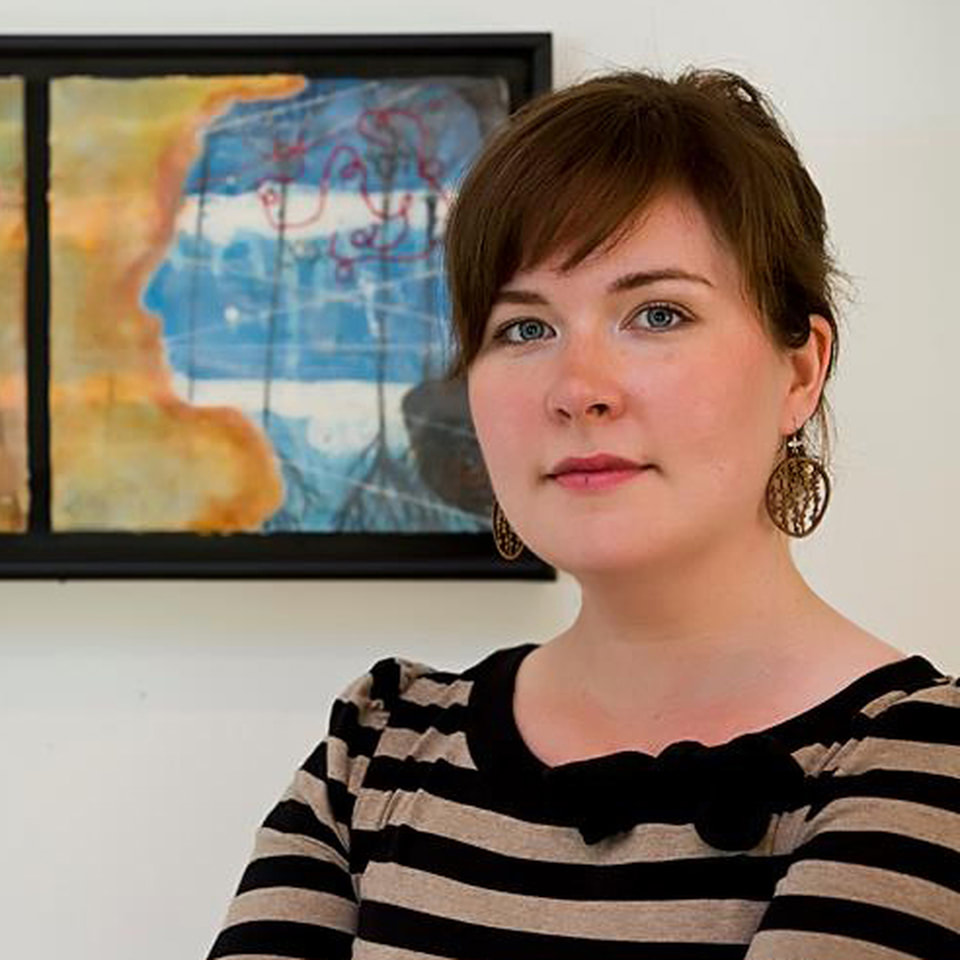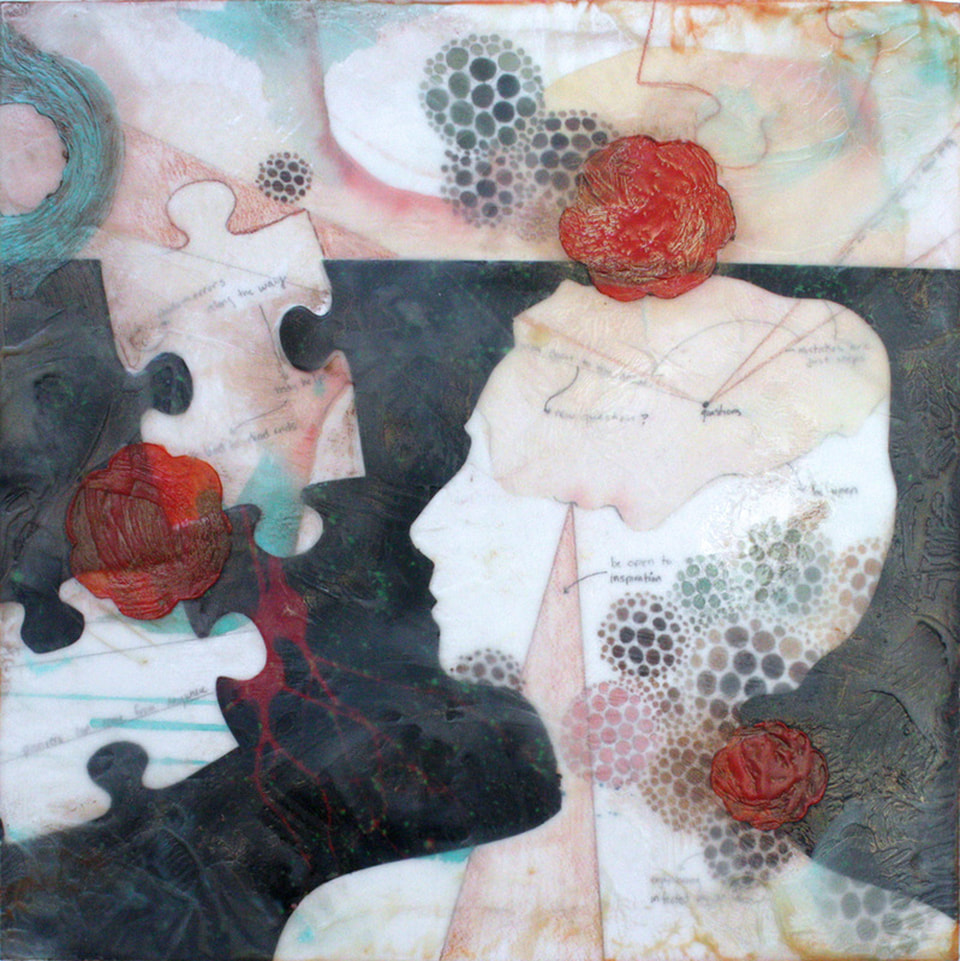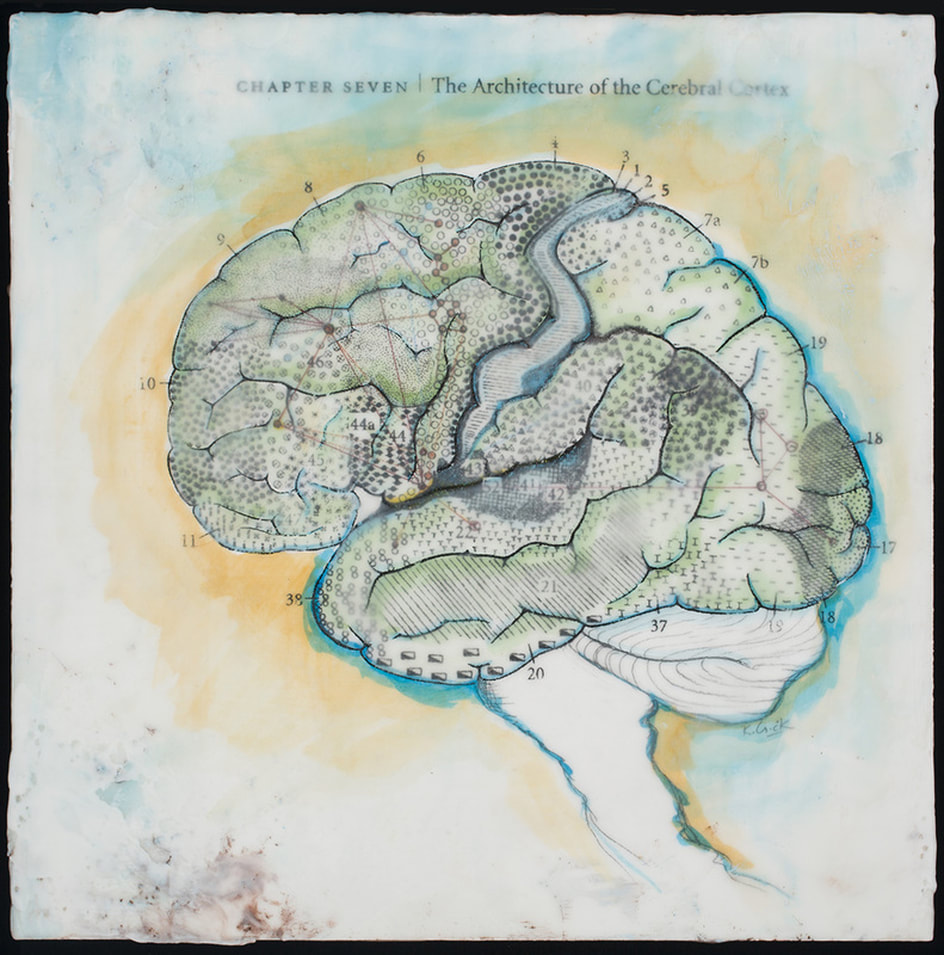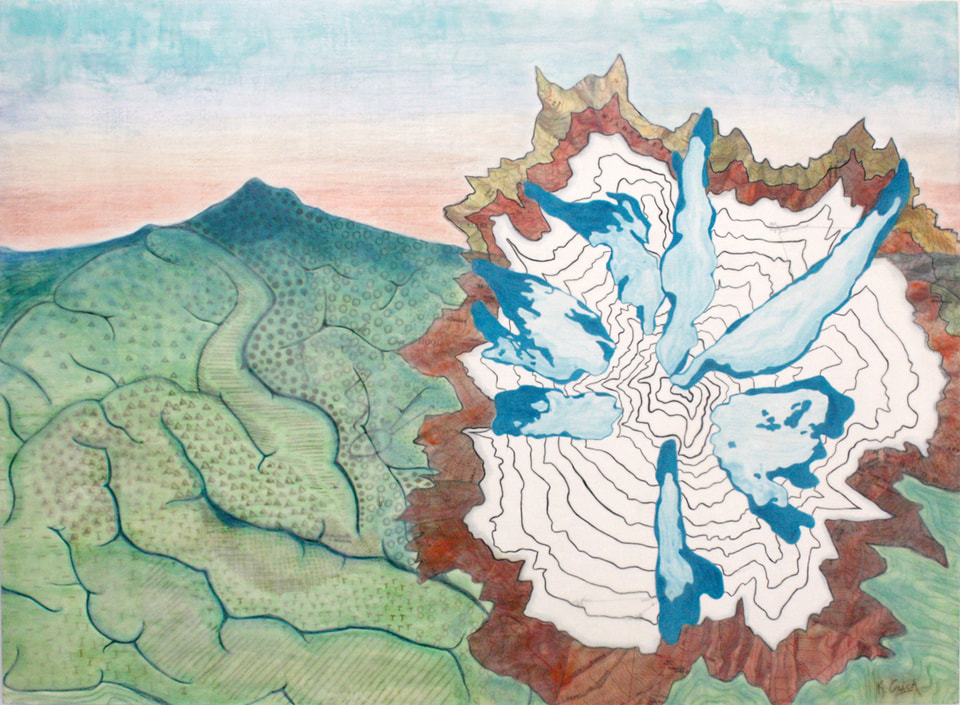ES: There is quite an awesome history of SciArt in your family - your grandparents Francis and Odile Crick being a wonderfully literal example of the marriage of science and art. How has this connection provided insight to your own discoveries and work?
KC: The idea that art is a perfect complement to science has been a constant in my life. One of the most iconic diagrams in science, the DNA double helix, was first drawn by my grandmother, Odile Crick. Although her typical artwork explored the human form, she was recruited by my grandad, Francis Crick, to provide the insightful diagram for the 1953 Nature article on the structure of DNA.
Growing up in a techie household outside Seattle, I also had access to painting materials and computers to create artwork. But it was my visits to my grandparents’ home in La Jolla, California, that captivated my imagination. My most memorable visit was the summer after my freshman year at Princeton when I was trying to decide my major. My grandad arranged for me to be an intern in a neuroscience lab at The Salk to learn the nitty gritty of research. Weekdays were filled with DNA gels and watching neural tube development under the microscope. Weekends were spent drawing in my grandmother’s sunlit studio where she would provide materials, hire models, and provide guidance. My informal science and art education was enhanced by conversations with artists and neuroscientists at leisurely lunches beside my grandparents’ pool. Discussions of vision and the neural correlates of consciousness or questions like “How do we perceive the blueness of blue?” ignited my interest in both subjects. My grandparents encouraged my pursuit of the seemingly disparate studies of art and science.
At school, I embraced the study of molecular biology but balanced it with my passion for drawing and painting by developing visuals and materials for campus theater. Biology itself is a visual subject, rich with a tradition in observation and communication through art. I discovered this in the drawings by naturalist and artist Maria Sibylla Merian who first described the metamorphosis of the butterfly. I still enjoy research, but I feel most driven when I am making art. My early experiments with the marriage of art and science came while at the School of the Art Institute of Chicago. In my paintings, I incorporated imagery from my observations under the microscope in the lab where I had worked on BRCAI and BRCA2. Cancerous fibroblasts would envelop my canvas in layers. The birth of my daughter and my obsession with the new research on the biological basis of love fully crystalized my passion for merging science and visual expression. A series of prints and paintings questioning the science and symbolism of one of our most basic drives, love, soon followed.
KC: The idea that art is a perfect complement to science has been a constant in my life. One of the most iconic diagrams in science, the DNA double helix, was first drawn by my grandmother, Odile Crick. Although her typical artwork explored the human form, she was recruited by my grandad, Francis Crick, to provide the insightful diagram for the 1953 Nature article on the structure of DNA.
Growing up in a techie household outside Seattle, I also had access to painting materials and computers to create artwork. But it was my visits to my grandparents’ home in La Jolla, California, that captivated my imagination. My most memorable visit was the summer after my freshman year at Princeton when I was trying to decide my major. My grandad arranged for me to be an intern in a neuroscience lab at The Salk to learn the nitty gritty of research. Weekdays were filled with DNA gels and watching neural tube development under the microscope. Weekends were spent drawing in my grandmother’s sunlit studio where she would provide materials, hire models, and provide guidance. My informal science and art education was enhanced by conversations with artists and neuroscientists at leisurely lunches beside my grandparents’ pool. Discussions of vision and the neural correlates of consciousness or questions like “How do we perceive the blueness of blue?” ignited my interest in both subjects. My grandparents encouraged my pursuit of the seemingly disparate studies of art and science.
At school, I embraced the study of molecular biology but balanced it with my passion for drawing and painting by developing visuals and materials for campus theater. Biology itself is a visual subject, rich with a tradition in observation and communication through art. I discovered this in the drawings by naturalist and artist Maria Sibylla Merian who first described the metamorphosis of the butterfly. I still enjoy research, but I feel most driven when I am making art. My early experiments with the marriage of art and science came while at the School of the Art Institute of Chicago. In my paintings, I incorporated imagery from my observations under the microscope in the lab where I had worked on BRCAI and BRCA2. Cancerous fibroblasts would envelop my canvas in layers. The birth of my daughter and my obsession with the new research on the biological basis of love fully crystalized my passion for merging science and visual expression. A series of prints and paintings questioning the science and symbolism of one of our most basic drives, love, soon followed.
The bond between disciplines is paramount in my next project with Cancer Research UK. I’ve been invited as one of 21 artists, including Ai Weiwei and Benjamin Shine, to express “What’s in your DNA?” Artists have been given 7ft sculptures based on the iconic double helix of DNA. The surfaces of the sculptures act as blank canvases for our interpretations of the question. The DNA sculptures have been created to raise awareness and money for The Francis Crick Institute, a world-leading center of biomedical research and innovation due to open in London next year. The sculptures will be auctioned at Christie’s on September 30th with all the money raised going to The Crick Institute.
ES: How does the interplay of processes such as experimentation and representation inform your choice of visual mediums?
KC: My major theme focuses on science’s quest to better understand ourselves by studying the brain. My interests lie in the biological bases of what seems visceral and intangible — love, empathy, creativity and memory. Sometimes I follow cutting edge research with all its missteps and conjecture; other times ideas stem from articles I have read that have been slowly percolating until they finally rise to the surface. My process starts with the visual representations of concrete terms used in science — diagrams, data, molecules, and microscopic images. Armed with these images, I venture into the more expressive realm of visual expression. I use trial and error, shutting down any inner critic and work intuitively (some believe by inhibiting the dorsolateral prefrontal cortex). Getting into the ‘flow’ of creating is what makes painting a highly absorbing and gratifying experience for me. Seeing how molecules are glorified when they change scale and how handwritten lines of text and images of cell growth become layered textures absorbs my attention. Because I work intuitively the process of problem-solving is a constant. I create a framework to work within, but leave myself open to the push and pull of composition, color and form. There is something wholly satisfying about painting my way out of an obstruction. Unexpected challenges might force me to rethink my approach and come up with novel solutions.
ES: How does the interplay of processes such as experimentation and representation inform your choice of visual mediums?
KC: My major theme focuses on science’s quest to better understand ourselves by studying the brain. My interests lie in the biological bases of what seems visceral and intangible — love, empathy, creativity and memory. Sometimes I follow cutting edge research with all its missteps and conjecture; other times ideas stem from articles I have read that have been slowly percolating until they finally rise to the surface. My process starts with the visual representations of concrete terms used in science — diagrams, data, molecules, and microscopic images. Armed with these images, I venture into the more expressive realm of visual expression. I use trial and error, shutting down any inner critic and work intuitively (some believe by inhibiting the dorsolateral prefrontal cortex). Getting into the ‘flow’ of creating is what makes painting a highly absorbing and gratifying experience for me. Seeing how molecules are glorified when they change scale and how handwritten lines of text and images of cell growth become layered textures absorbs my attention. Because I work intuitively the process of problem-solving is a constant. I create a framework to work within, but leave myself open to the push and pull of composition, color and form. There is something wholly satisfying about painting my way out of an obstruction. Unexpected challenges might force me to rethink my approach and come up with novel solutions.
I typically work in a mixture of media with encaustic, a combination of beeswax and resin that unites everything. Encaustic allows me to obliterate and to rediscover layers. Embedded drawings, diagrams, maps and microscopic images can be incised, written upon and scraped back to previous layers. I enjoy the unearthing process. When I experiment with sculpture, I incorporate classic tools of science like vials and beakers. These pieces are more conceptual and add context to my paintings. Moments for discovery are also important for the viewer of an artwork. Pleasure comes from the act of understanding or ‘binding’ the image, context, and internal language. In some cases, the more unexpected the connections made the more gratifying the experience.
ES: What do you think is most important about expanding a SciArt discourse?
KC: Just as science is always striving towards greater understanding by constantly testing and widening its field of vision, so must our ventures into the territory of SciArt. The act of giving the SciArt discourse a name has already been a key step in moving the conversation forward and providing a bridge between the ‘two cultures’ of science and art. I think it is important not to dwell too much on the exact definition of the term, but to use it to inspire additional work and dialogue.
As SciArt develops it will reach critical mass in the mainstream. For the last four years the research facility MDI Biological Laboratory has advanced the dialog with their ‘Art Meets Science’ annual exhibition that celebrates creativity and the ability to see the world from new perspectives. I’ve been participating in this exhibition for the last two years. I’m also encouraged to see more galleries putting out calls to artists for science-based and science-inspired artwork, as the audience for these works is broadening.
ES: What do you think is most important about expanding a SciArt discourse?
KC: Just as science is always striving towards greater understanding by constantly testing and widening its field of vision, so must our ventures into the territory of SciArt. The act of giving the SciArt discourse a name has already been a key step in moving the conversation forward and providing a bridge between the ‘two cultures’ of science and art. I think it is important not to dwell too much on the exact definition of the term, but to use it to inspire additional work and dialogue.
As SciArt develops it will reach critical mass in the mainstream. For the last four years the research facility MDI Biological Laboratory has advanced the dialog with their ‘Art Meets Science’ annual exhibition that celebrates creativity and the ability to see the world from new perspectives. I’ve been participating in this exhibition for the last two years. I’m also encouraged to see more galleries putting out calls to artists for science-based and science-inspired artwork, as the audience for these works is broadening.
Kindra lives and works in Portland, Oregon. Check out more of her work at www.kindracrick.com. To contact Kindra email her at [email protected].





